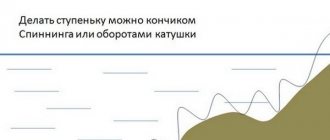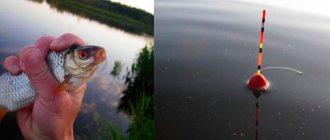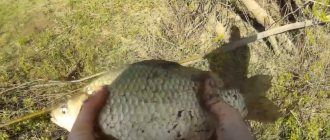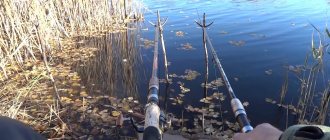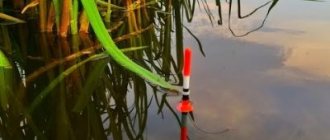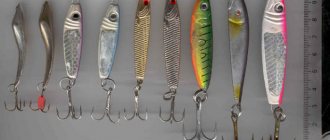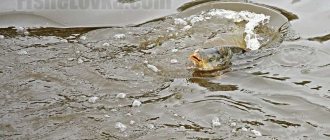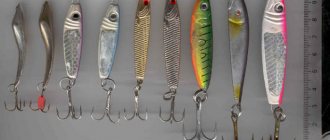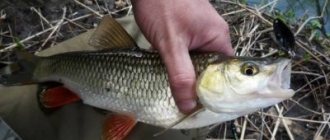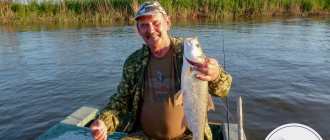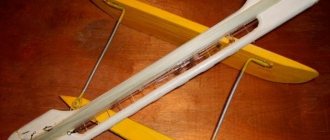Winter equipment for pike perch and pike: catching up with an amphipod or balancer
There are quite a lot of different combined equipment for spinning fishing in the open water season. The same cannot be said about equipment for winter fishing. Yes, many variations of rigs have been developed for jig fishing, where in addition to the main bait, additional ones work - a garland (train), hooks on a branch, etc. But for catching pike perch or pike, there are not so many winter equipment. Catch-up is one of the most effective equipment for winter fishing when it comes to purposefully catching pike perch or pike. And the bycatch may also include large perch.
Equipment
To catch asp with a beard, a spinning rod is used. It should be of normal rigidity, from 2.5 to 3 meters long. You will also need the following items:
The beard is crocheted. It is necessary to knit tightly so that the hairs cannot be pulled out. Mount the streamer with a white cambric or foam float. If rotating or oscillating spinners are equipped with a beard, then use wool that is half as long.
To mount the equipment, you need a 1 meter piece of fishing line. Swivels are prepared at its ends. One end is equipped with a regular swivel, and the other with a clasp. A spinner or castmaster is attached to a swivel with a clasp.
The first streamer is attached to a 5-7 centimeter leash 25-30 centimeters from the swivel with a clasp. The second streamer is a little higher, at the same distance and on the same leash. The main line is tied to the swivel without a fastener. When fishing with a spinning rod, to increase sensitivity, you can use a cord rather than a monofilament line.
Photo 2. Approximate equipment diagram.
Amphipods and catching pike perch
The catch-up rig is a fluorocarbon leash with a diameter of 0.3-0.4 mm, at the end of which an amphipod-type bait is attached. As you know, amphipod is one of the most catchy baits for winter fishing for pike perch. In addition to pike perch, it also catches pike and large perch.
Amphipod-type baits
But the effectiveness of the equipment increases significantly when a “catch-up” is installed on a fluorocarbon leash - this is a double, on the fore-end of which there is a short bunch of holographic tinsel (Lurex, hairs), wrapped with colored threads. This is something similar to a clipped streamer or assist type hook.
As for the diameter of the leash, it is selected based on whether the pike takes it. If there is a possibility of a pike biting, and it is often included in the bycatch when fishing for pike perch, then it makes sense to make it thicker. A diameter of 0.4 mm is more likely to withstand the friction of the sharp teeth of a pike. If there is no pike, you can make the leash thinner.
The catch-up looks like this:
Catch-up - elements of winter equipment
The equipped double is suspended on a leash above the main bait, the role of which can be played by an amphipod or a balancer. It is believed that amphipods are more effective for catching pike perch than other types of winter baits.
In this case, the chaser is not tied, but slides with hooks up a meter-long fluorocarbon leash, at one end of which there is a bait, and at the other a swivel for attaching to the main fishing line.
Tackle for spinning predator fishing “Beard”
Tackle for spinning predator fishing “Beard”
“Beard” is extremely popular among fishermen in the Kyiv region. With its help it is possible to catch pike, pike perch, asp, perch and other predatory fish
. Among the non-traditional trophies are saberfish, chub, and ide.
The “beard” itself is not the key to success; it is only part of the tackle for catching these fish. If you want to try fishing using a “barb”, you will need a medium-hard spinning rod with a length of 2.5-2.8 meters, an inertial reel of the “Nevskoy” type, a main line with a diameter of 0.6 and a leader line - 0.35-0.40, black strong single or triple hooks, ball-shaped sinkers weighing 32 grams.
The “beard” is crocheted. It may be made from bird feathers, beaver fur, sheep wool, cat hair, but optimally - goat or goat. To do this, you first need to make a bunch of hairs of the same length, evenly cover the hook with it, coat the wool closer to the hook ring with glue and wrap it well with threads, on which again apply a thin layer of glue. If, after the “beard” has dried, you try to pull out a couple of hairs from it, but this does not work, then the bait is made well. At different times of the year, fish prefer “beards” of different colors.
The “beard” can be mounted with a foam float (Fig. 1, a) or with a white cambric (Fig. 1, b), which some fans prefer to cover with thin candy foil. It is possible to add 1-2 stripes of New Year’s “rain” to the bundle of hairs. It is possible to equip oscillating and rotating spoons with “beards”, but in this case the wool should be half as long (Fig. 2, a, b).
Assemble the tackle as follows:
First option . The fishing line is passed through all the rings of the spinning rod; at the end of the tulip, there should be one and a half meters of free fishing line left, to which the tackle is attached. First, two leashes, also made from fishing line, are tied to the main fishing line, they are threaded through the floats, and hooks with “barbs” are connected to the ends of the leashes. After this, the floats are moved to the shanks of the hooks. The sinker is attached using a swivel (Fig. 3, a).
Second option . The sinker is connected to the main fishing line by means of a fastening pin, to which an iron leash is also attached, and to it - a leash made of fishing line with a float and a “beard” (Fig. 3, b). In both cases, the tackle is thrown out and allowed to sink to the bottom. After this, lift the tip of the rod, moving it slightly to the side, and wind the excess fishing line onto the reel. In three short jerks, the tackle is moved along the bottom, the excess fishing line is again taken out - and without that, until the tackle appears near the shore. In the water, the “beard” moves irregularly and thereby attracts a predator. This is how they mainly catch perch and pike perch. If the hunt is for pike, then the reel is rotated slowly and the tackle is slowly dragged along the bottom. During reeling, it is possible to stop the tackle for 1-2 seconds and then start reeling again.
The third version of the tackle is used for catching asp. It does not submerge in water, but remains afloat thanks to a huge cone-shaped float made of cork or foam with a built-in sinker. It is better to use “barbs” with cambrics on such tackle (Fig. 3, c). After casting, the tackle must be slowly reeled in. The bite is visible visually and is similar to the fight of an asp; it is felt through the fishing line as a jerk.
Catching pike perch from the shore with a spinning rod using a Killer Walleye tackle
Pike perch on a beard.
Source: nogov.ru
How to make a catch-up rig
In general, when you have the main bait, all that remains is to equip the double. And there are many ways to do this.
One of them is that the forend of the double is wrapped evenly, in one layer, with red or yellow thread, and lurex or other material folded in half is applied. And then it is wrapped with the same thread on top. Excess lurex is trimmed with scissors so that about a centimeter bunch remains.
To make the bait last longer, the thread is treated with transparent waterproof glue or varnish. When everything is dry, the catcher is ready for fishing.
You can’t find such doubles on sale yet, so you’ll have to do a catch-up with your own hands.
Watch a short video that shows how this catch-up is done:
Another, simpler manufacturing method is to use a heat-shrinkable tube under which tinsel is placed. Threads and glue are no longer needed here, and the process itself is significantly accelerated.
How to catch pike perch by catching up
When we have ready-made equipment, the only thing left to do is find a hunting spot for pike perch. But everything is simple only in words. In fact, those anglers who know how to look for walleye understand that it is not always an easy task. Especially on an unfamiliar body of water.
But when you know where the pike perch is hiding under the ice, catching it is not difficult. The technique of catch-up fishing and wiring is no different from the standard one. At the same time, the equipment works even if the pike perch is inactive and does not want to take on other pike perch equipment.
This may include:
- Jig game;
- Short jerks followed by a fairly long pause;
- Combinations of various playing techniques.
Each time you have to look for the most effective wiring technique, adapting to the activity of pike perch or pike.
The following video will help you understand how to catch pike perch using the equipment described above in practice.
Winter catch-up fishing for passive pike perch:
Catching asp with a bombard
The method of fishing with bombarda (or, as it is also called, sbirulino) was invented by the sports team “Team Daiwa” back in the last century. The simplicity and elegance of the equipment with a large bombard float allows you to successfully fish on 5 continents. The growing popularity of bombard fishing is associated with the opportunity to take advantage of two types of fishing - spinning and fly fishing. You can catch almost any fish with a bombard, but this tackle is especially effective when hunting fish that live in the upper layers of water. Recently, more and more anglers have been found on rivers using sbirulino when catching asp.
The method of fishing with bombarda (or, as it is also called, sbirulino) was invented by the sports team “Team Daiwa” back in the last century. The simplicity and elegance of the equipment with a large bombard float allows you to successfully fish on 5 continents. The growing popularity of bombard fishing is associated with the opportunity to take advantage of two types of fishing - spinning and fly fishing. You can catch almost any fish with a bombard, but this tackle is especially effective when hunting fish that live in the upper layers of water. Recently, more and more anglers have been found on rivers using sbirulino when catching asp.
Beard on reel
Beard on a reel; there is an opinion among fishermen that using a spinning reel, there will be no beard. I don’t know for whom, how, but for me, especially at the very beginning of my fishing journey, in particular, when I first started using this type of reel, everything happened to me.
I can already imagine how many will now begin to swear and think that this topic is “made up,” but in reality everything is not so simple. Let’s admit to ourselves that not everyone can afford to buy a real good branded reel, the price tag of which sometimes far exceeds 3-5 thousand rubles. I have already repeatedly emphasized that one of my spinning rods (bought, by the way, also on the market) has a reel installed from a completely unknown manufacturer. No, there was some kind of label when purchasing, but should you believe what was written... And its cost was only about 400 rubles. And I have been using this reel for a long time, although I admit that there are some shortcomings.
I also had reels in my arsenal that literally crumbled in my hands as soon as I applied some load. For example, once when the spinner caught a snag on the bottom, I pulled the spinning rod hard. And despite the fact that the line should have broken due to the increased loads, the spool was torn out of the reel. I also have reels in my arsenal for 5,000 rubles, these are Excia mx 4000, but we’ll talk about it a little later. Now, when visiting the fishing market, I see more and more spinning reels for adequate money, but the quality of which, at least externally, upon inspection, is very good, so to speak, inspires confidence.
So, I won’t hide the fact that with some flaws in the production of reels, with incorrect winding of the line on the spool, with defects in the operation of the line layer itself, situations are possible in which the next cast will be characterized by a very, very good beard, akin to the one that occurs with an inexperienced a fisherman who decided to master the most common inertial reel. In general, I concluded for myself that tangling of fishing line and braid is possible both on an inertial reel and on a more advanced and more familiar to the modern fisherman, a spinning reel.
By the way, you probably also noticed that sometimes (especially if fishing is done using braid), particles of algae, duckweed and other particles of vegetation and organic matter get onto the reel spool. So, all this also does not serve the best purpose, and can easily become the reason that after making a good confident cast, the bait will literally fall under your feet (and even with a roar), and a certain number of meters of braid will become completely unusable. As they say, any angler must go through a beard, and he will go through this phenomenon.
Subtleties of asp fishing
Have you ever caught an asp who saw you?
There have been a couple of cases in which I am sure that I caught the right one.
The main thing is that after the first splash “under your feet”, quietly change
location. Estimate the route of the hunting fish (you can sit for five to seven minutes, wait for splashes), and continue fishing from afar, being outside the route. That is why long-range tackle is always preferable - you have to not only cast far across the river, but also along it if the bank is without shelter. And then it turns out that at the point of impact of the attacking asp the depth is knee-deep, and there are holes from one’s own boots
